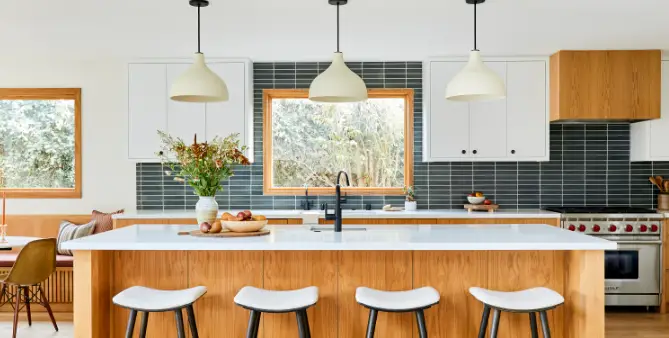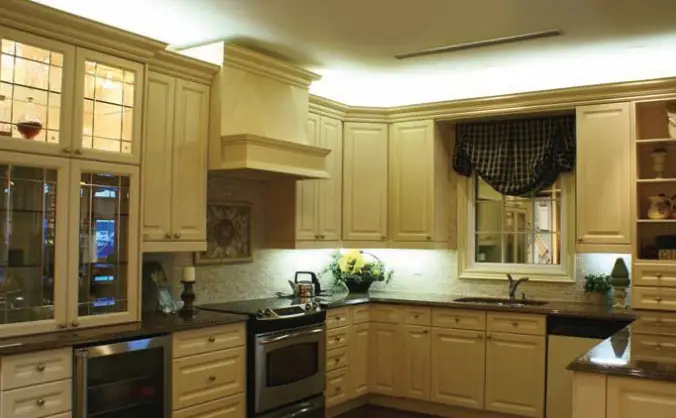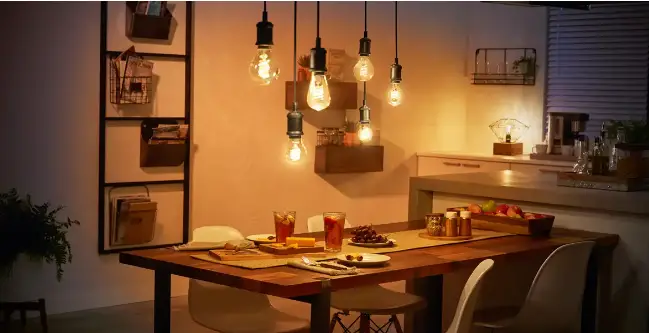Looking to pair your kitchen and dining lights? That can be an exquisite design to play a double illumination in the two rooms. The layout is popular as it is an open concept where the kitchen and dining have no separating walls. Learning how to pair kitchen and dining lights can help improve the aesthetics of the two rooms.
We have cost-effective suggestions that help you match the lights and make the dual space velvety. Discover how to pair kitchen and dining lights in 8 steps including style, lighting zone, fixtures, placement, dimmers, and testing. Besides the steps to pairing kitchen and dining lights, there are more considerations and tips. Let’s begin with the steps to these lighting finishes
8 Steps On How To Pair Kitchen And Dining Lights

Pairing your kitchen and dining lights can create a cohesive and harmonious lighting design in your home. Here are the steps to follow:
1. Determine The Lighting Style
The premier step for pairing your lights is to decide on the lighting style that you want to achieve in both the kitchen and dining area. Consider factors such as the ambiance, functionality, and aesthetics you desire. Choose between similar or complementary lighting fixtures to establish a consistent theme throughout the space. Before you proceed, you need also to master low ceiling kitchen lighting ideas. You might need the tips if your ceilings are low.
2. Consider Lighting Zones
Assess the layout of your kitchen and dining area to identify different zones that require specific lighting. For example, task lighting is essential for food preparation areas, while ambient lighting creates a comfortable atmosphere for dining. Identify the specific lighting needs for each zone to guide your fixture selection.
3. Choose Compatible Fixtures
Select lighting fixtures for the kitchen and dining area that complement each other visually. Consider factors such as the size, style, and finish of the fixtures. An example is where you have floating kitchen cabinets. You must take care to have a match and illuminate all the areas. While the fixtures don’t have to match exactly, you should have a cohesive design language that ties the spaces together.
4. Coordinate Lighting Characteristics
Mix and match lighting requires a keen eye. Pay attention to the characteristics of the light emitted by the fixtures, such as color temperature and brightness. Aim for consistency in these aspects between the kitchen and dining lights to create a seamless transition. For instance, if you opt for warm white lighting in the kitchen, choose a similar color temperature for the dining area.
5. Plan the Placement:
Determine the ideal placement of the fixtures in both the kitchen and dining area. You can consider low ceiling kitchen lighting ideas. This step also involves coordinating lighting in open floor plan. Ensure adequate illumination in the intended areas, you don’t need to bang your head. Also, avoid glares and shadows in your kitchen. Install task lighting above work surfaces in the kitchen and consider pendant lights or other alternatives to chandelier over dining table and area.
6. Install Dimmers

Dimmers are part of lighting finishes. Incorporate the right switches for both the kitchen and dining lights. Dimmers allow you to adjust the intensity of the lighting, creating different moods and accommodating various activities. This flexibility is especially useful for the dining area, where you may desire softer lighting during meals or more vibrant lighting for gatherings.
7. Test and Adjust
Once the fixtures are installed, test the lighting in both areas to ensure they work harmoniously. Pay attention to the overall ambiance, functionality, and visual coherence between the kitchen and dining lights. Make any necessary adjustments to achieve the desired lighting effect.
8. Evaluate and Refine:
Finally, you have your lights ready. You have also completed coordinating island and dining room lighting. Remember that you will live with the paired kitchen and dining lights for some time, so assess their effectiveness. The lighting finishes are not a life sentence. You can make further refinements if needed. Consider feedback from family members or guests to ensure the lighting meets their expectations and enhances the overall dining experience.
By following the above steps, you can effectively pair your kitchen and dining lights, creating a unified and inviting space for cooking, dining, and entertaining.
Further Tips On How To Pair Kitchen And Dining Lights
When pairing your kitchen and dining lights, consider the following;
- Size and layout of the kitchen and dining area
These two rooms might occupy a larger space than your living room. But that depends on your house. Overall, the lighting should match the size. For larger spaces, consider more lighting installations. Conversely, smaller areas will benefit more from smaller and more compact lighting options.
- The Style Of Your Home
Every home is different and unique. Your home style determines how to pair kitchen and dining lights. For instance, a modern home may require sleek and minimalistic lighting options. Traditional homes go well with ornate lighting finishes. You may also find a mix and match lighting a great style in your kitchen and dining.
- The Purpose Of Each Space
Determining the purpose of your kitchen and dining space gives you leeway when choosing the lighting. Consider brighter and functional lighting for your kitchen and inviting, ambient lighting for the dining area. The dining area lighting should be mood-setting.
- Adjustable Lighting
Adjustable lights can fit different situations and needs. For instance, party times, day, night, and other occasions. Dimmers can help you to adjust your lights depending on the time of day and other occasions.
- Layering
Ever heard of layering effects in lighting? This design combines kitchen and dining overhead lights, under-cabinet lights, a sconce over the kitchen sink, and task lighting to generate a well-lit, functional kitchen, and dining area. For the overhead lights, you can combine chandeliers and pendant lights. Also, table lamps create a warm and inviting ambiance.
Final Words
If you have been wondering how to pair kitchen and dining lights, it is easier now. The two rooms have no separation, but their purposes are different, so, you will have several considerations, including the function and style. Also, consider the size and layout of your cooking and dining area. Hand-picking the lights can complement both rooms and help with mix and match lighting. The above steps allow you to create an inviting and well-lit space for cooking and dining in your home.


